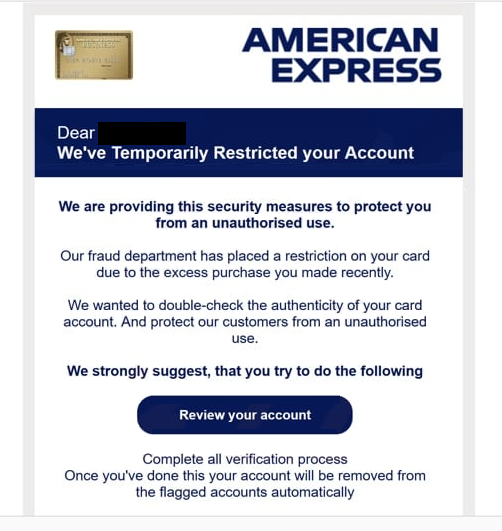Remove “American Express – We’ve temporarily restricted your account” email
The “American Express – We’ve temporarily restricted your account” email is a phishing email designed to steal users’ online banking login credentials. It is made to appear as a legitimate security alert from American Express, falsely claiming that your card has been restricted because of excessive purchases made from your account. The email urges you to review your account for security purposes by clicking a provided button. However, clicking the button redirects you to a phishing website that mimics the appearance of the official American Express site. Entering credentials on this phishing site allows cybercriminals behind the campaign to capture the information, potentially granting them access to the victim’s account and enabling unauthorized transactions.
The “American Express – We’ve temporarily restricted your account” phishing email is supposed to mimic an official notification from American Express. The email warns you that a restriction has been placed on your card because of excessive purchases. The email does not provide more information, only that you need to review your account. It includes a “Review your account” button, which redirects recipients to a phishing website.
These phishing sites are typically designed to closely resemble legitimate sites in appearance, though their URLs will always differ, which is how users can always differentiate them. Entering your login credentials on this phishing site results in them being sent to the malicious actors operating the phishing campaign. Cybercriminals can then exploit the stolen information to access your account and conduct unauthorized transactions.
The full “American Express – We’ve temporarily restricted your account” email contents are below:
Subject: Dear -, We’ve Temporarily Restricted your Account –
American Express
Dear -,
We’ve Temporarily Restricted your AccountWe are providing this security measures to protect you from an unauthorised use.
Our fraud department has placed a restriction on your card due to the excess purchase you made recently.
We wanted to double-check the authenticity of your card account. And protect our customers from an unauthorised use.
We strongly suggest, that you try to do the following
Review your account
Complete all verification process
Once you’ve done this your account will be removed from the flagged accounts automaticallyYour account security is important to us. We are sorry for any inconviniences.
Thank you for your Card Membership.
Sincerely,
The American Express Fraud protection Team
Login credentials are very valuable to malicious actors, particularly those associated with financial accounts. Therefore, being able to recognize phishing emails is an important skill to have if you want to protect your financial accounts. If you have become a victim of such a phishing scam, you need to contact American Express immediately to report the incident and take steps to prevent unauthorized access to your online banking account and potential transactions.
How to recognize a phishing email
A lot of phishing campaigns tend to target a large number of users with the same email, which means the emails are generic and relatively easy to identify. Generic phishing emails are usually not personalized and often contain several spelling and grammar mistakes. The “American Express – We’ve temporarily restricted your account” email is a perfect example because it’s full of mistakes, which immediately gives it away as malicious. However, more sophisticated phishing campaigns targeting specific individuals or companies may have highly credible-looking emails that are harder to distinguish from legitimate ones. Fortunately, the majority of phishing emails encountered tend to be the simpler, more recognizable type.
The first thing to check in an unsolicited email urging you to click a link or open an attachment is the sender’s email address, particularly if the sender claims to be from a bank or government agency. Doing a quick search can help confirm whether the email address is legitimate. If no information about the email address can be found, it is malicious. Generic phishing emails often originate from random, clearly suspicious addresses, while more advanced campaigns might use addresses that at least somewhat resemble those of reputable companies or organizations, in this case, American Express. This “American Express – We’ve temporarily restricted your account” email can easily be identified as a phishing attempt because it was not sent from an address used by this bank.
How an email addresses you can also tell you a lot about whether it’s legitimate. If you are addressed by your username, generic words like users, member, customer, etc., or are not addressed at all, it could indicate a phishing attempt. All emails from companies whose services you use will address you by name.
Always exercise caution when dealing with emails that demand immediate action, such as clicking a link or opening an attachment. Always check the URL of a site before logging in, and whenever possible, do not click on links in emails altogether.
Site Disclaimer
WiperSoft.com is not sponsored, affiliated, linked to or owned by malware developers or distributors that are referred to in this article. The article does NOT endorse or promote malicious programs. The intention behind it is to present useful information that will help users to detect and eliminate malware from their computer by using WiperSoft and/or the manual removal guide.
The article should only be used for educational purposes. If you follow the instructions provided in the article, you agree to be bound by this disclaimer. We do not guarantee that the article will aid you in completely removing the malware from your PC. Malicious programs are constantly developing, which is why it is not always easy or possible to clean the computer by using only the manual removal guide.

